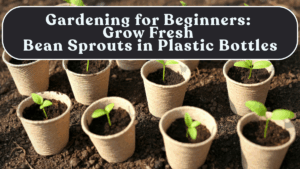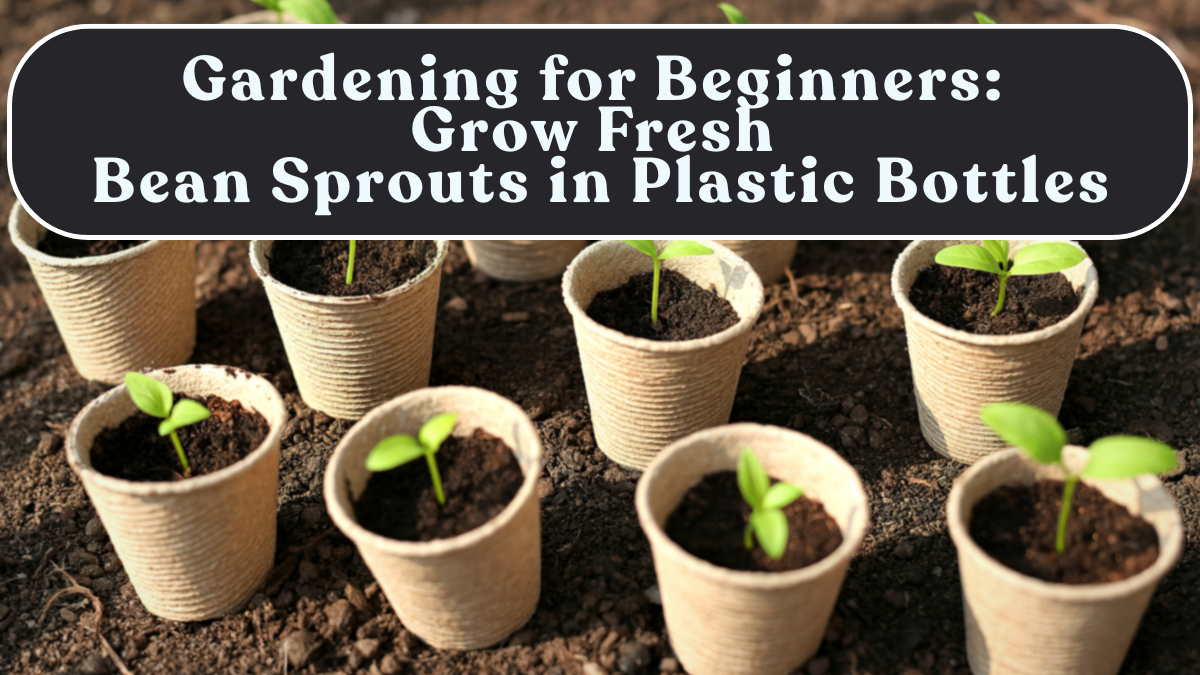If you’re looking for a simple, fun, and eco-friendly gardening project, learning how to grow bean sprouts in plastic bottles is a perfect place to start. It’s fast, low-cost, and doesn’t require soil—making it a great example of kitchen hydroponics. Within just four days, you can have a batch of crunchy, protein-rich sprouts ready to eat, all grown right on your kitchen counter.
This easy method is ideal for beginners, apartment gardeners, or anyone who wants fresh produce year-round without investing in garden space.

Why Grow Bean Sprouts at Home?
Bean sprouts are packed with nutrients, especially vitamin C, fiber, folate, and antioxidants. When grown at home, they’re fresher, tastier, and more hygienic compared to store-bought ones.
Home sprouting also:
-
Reduces food waste by reusing bottles.
-
Takes very little space—ideal for balconies or windowsills.
-
Saves money while promoting sustainable living.
In short, it’s one of the easiest and healthiest forms of urban gardening you can try.
What You’ll Need
To grow bean sprouts in bottles, gather the following materials:
-
1 clean plastic bottle (1- or 2-liter size).
-
Mung beans or soybean seeds (organic, untreated).
-
A piece of muslin cloth or a fine mesh to cover the opening.
-
Rubber band or thread to secure the mesh.
-
Clean water and a dark corner for storage.
Optional: You can cut the top of the bottle slightly for easier rinsing or use multiple bottles to grow batches simultaneously.
Step-by-Step Growing Process
1. Prepare the Beans
Rinse about 2 tablespoons of beans thoroughly in clean water. Soak them overnight (8–10 hours) until they swell up. This activates germination.
2. Set Up the Bottle
Drain the soaked beans and put them into the bottle. Cover the mouth of the bottle with the mesh or cloth and secure it tightly. This allows airflow while preventing bugs or dust from entering.
3. Rinse Twice Daily
Twice a day—morning and evening—fill the bottle with fresh water, swirl gently, and drain. Keep the bottle tilted upside down at an angle so excess water can drain completely. This prevents mold or odor buildup.
4. Store in a Dark Place
Sprouts grow best in the dark, as this keeps them tender and white. Store the bottle in a dark, cool place such as a cupboard or under the sink.
5. Harvest in 3–4 Days
Within 3 to 4 days, your bean sprouts will be ready—about 2 to 3 inches long. Rinse them once more before use, and they’re ready to add to your salads, stir-fries, or soups.
Tips for Better Growth
-
Use filtered or boiled water for rinsing to keep sprouts hygienic.
-
If the weather is hot, rinse three times daily to prevent overheating.
-
Don’t overcrowd the bottle—beans need space to breathe.
-
For longer, thicker sprouts, keep them in darkness for an extra day.
Following these steps ensures that your sprouts remain crisp, clean, and nutrient-rich.
Health Benefits of Bean Sprouts
Fresh sprouts are loaded with digestive enzymes and promote gut health. They’re also:
-
Low in calories and rich in protein—ideal for weight watchers.
-
Support immune function with antioxidants.
-
Great for vegan and vegetarian diets.
-
Add crunch and nutrition to wraps, noodles, and smoothies.
Sprouts are also known to improve nutrient absorption and help reduce cholesterol when eaten regularly.
Conclusion
Growing bean sprouts in plastic bottles is one of the easiest DIY gardening activities you can do at home. It’s sustainable, cost-effective, and highly rewarding—turning a simple plastic bottle into a mini farm.
Whether you’re a beginner in hydroponic gardening or just looking for a quick health project, this method brings freshness right to your kitchen shelf. In just a few days, you’ll have your first homegrown batch—fresh, safe, and full of life.
FAQs
How many days does it take to grow bean sprouts in bottles?
Usually 3 to 4 days, depending on room temperature and humidity.
Which beans are best for sprouting?
Mung beans, soybeans, and lentils are the most common and easiest to sprout.
Do I need sunlight for growing bean sprouts?
No, sprouts grow better in dark, cool places for a tender texture.
Can I reuse the same bottle?
Yes, as long as it’s cleaned thoroughly after each use to prevent mold buildup.
Are homegrown sprouts safe to eat?
Yes—if you use clean water, organic beans, and rinse regularly, they are completely safe and fresh.
